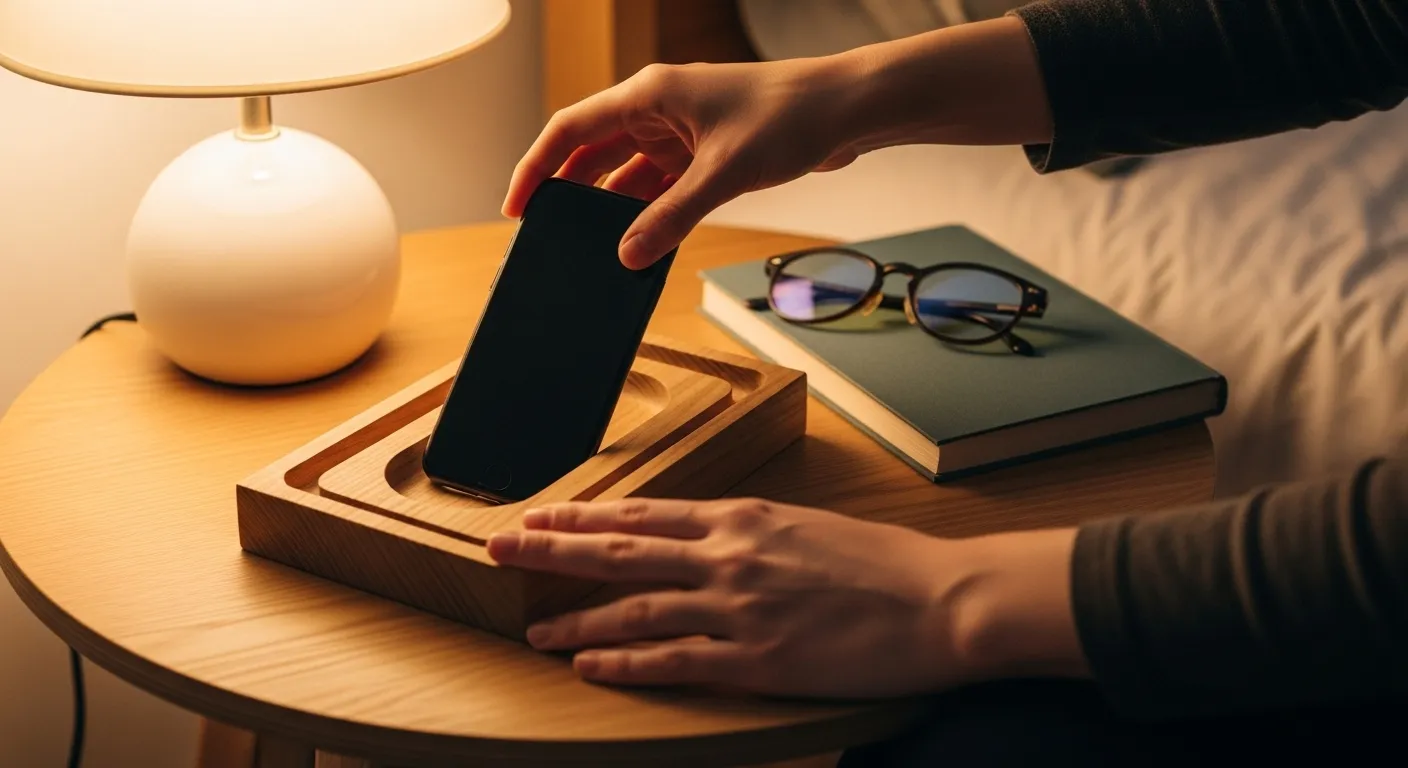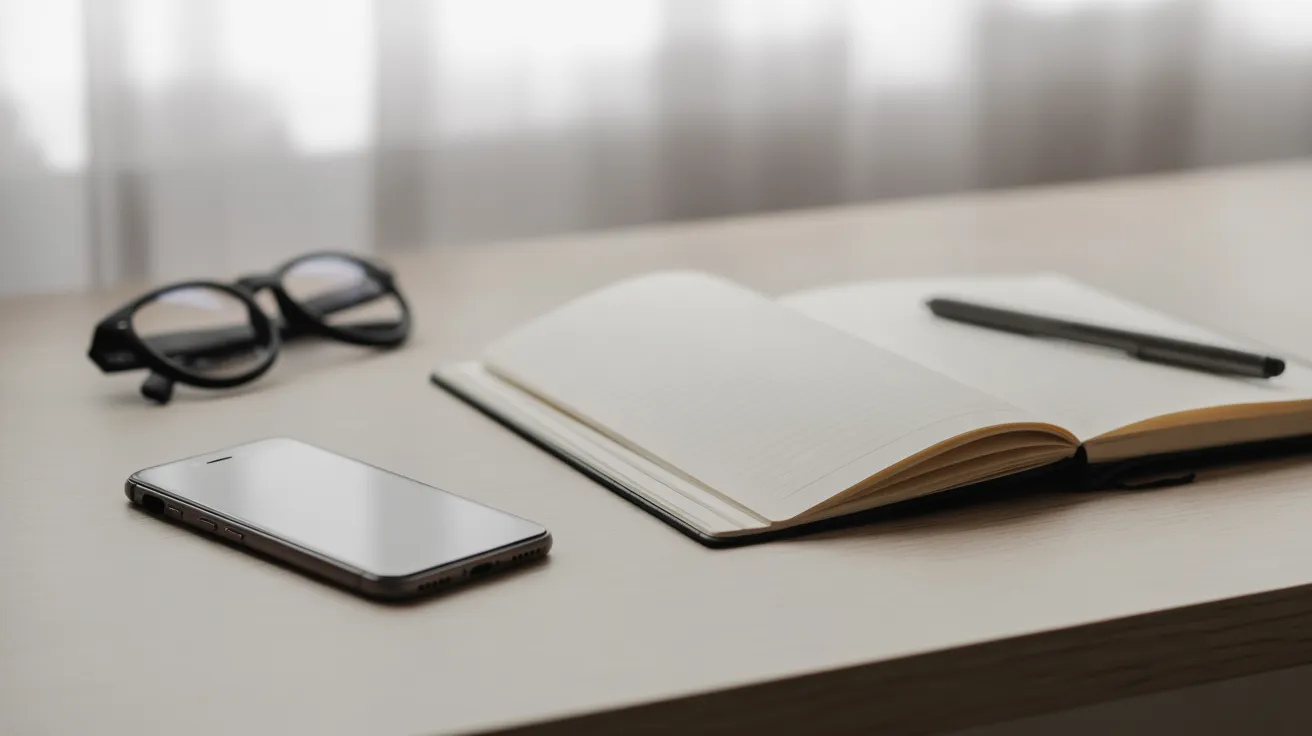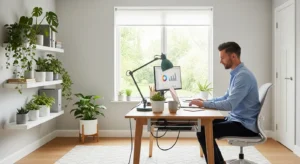
Does your phone feel less like a tool and more like an extension of your hand? Do you pick it up to check one thing, only to look up 45 minutes later, wondering where the time went? You are not alone. In our hyper-connected world, the line between using technology and being used by it has become incredibly blurred. The constant stream of notifications, updates, and infinite scrolling feeds can leave us feeling drained, anxious, and perpetually distracted.
The cost of this constant distraction is steep. It chips away at our ability to focus deeply on work, to be present with our loved ones, and to simply enjoy a quiet moment of thought. It can disrupt our sleep, heighten our anxiety, and leave us feeling like we’re always running a race we can’t win. Many of us want to change, to find a healthier balance, but the idea of a complete “digital detox” feels unrealistic and isolating.
What if the solution wasn’t to abandon technology, but to use it more wisely? What if you could use the very device that causes the distraction to help you reclaim your attention? This guide is for you. We’re not going to tell you to throw your smartphone away. Instead, we’ll explore how to build realistic boundaries and healthier habits. We will introduce you to five of the best apps for a digital detox that empower you to unplug, reduce your screen time, and build a more intentional relationship with your technology.
This is about shifting from mindless consumption to mindful use. It’s about making your phone work for you again, not the other way around. Let’s begin.
📚 Table of Contents
- Understanding the Invisible Tug: Why We Can’t Look Away
- Building Your Digital Fortress: 5 Apps to Reclaim Your Focus
- App 1: Freedom – The Digital Off-Switch
- App 2: Screen Time (iOS) & Digital Wellbeing (Android) – Your Personal Data Analyst
- App 3: Forest – Gamify Your Focus
- App 4: Opal – Add Intentional Friction
- App 5: F.lux & Native Night Modes – Protecting Your Sleep
- From Intention to Habit: Practical Routines and Environments
- The 10-Minute Evening Wind-Down: A Worked Example
- The Realistic Weekend Digital Detox
- Designing a Calmer Digital Environment
- Navigating the Bumps: Troubleshooting Your Digital Wellness Journey
- Handling “Relapse” Moments
- Conquering FOMO (Fear of Missing Out)
- Managing Social and Professional Expectations
- Making Room for Exceptions
- Frequently Asked Questions About Digital Detox Apps
- Are these screen time tracker apps safe for my privacy?
- I work a night shift. How can I adapt this advice?
- Can I use these apps for my children as well?
- My job requires me to be available 24/7. How can I possibly unplug?
- Your First Steps Toward a Healthier Tech Balance
Understanding the Invisible Tug: Why We Can’t Look Away
Before we dive into the solutions, it’s crucial to understand why our devices are so compelling. It isn’t a personal failing or a lack of willpower. App and platform designers are masters of human psychology, and they build features specifically designed to capture and hold our attention for as long as possible.
The primary mechanism at play is something called a dopamine loop. Dopamine is a neurotransmitter in the brain associated with pleasure and reward. When you do something enjoyable, like eating a delicious meal or receiving a compliment, your brain releases a small hit of dopamine, which makes you feel good and encourages you to repeat the behavior. Tech companies have engineered their apps to trigger this same reward system.
Think about the pull of a notification. Your phone buzzes, and a red badge appears. You don’t know what it is—it could be a work email, a “like” on your photo, or a breaking news alert. This unpredictability creates a variable reward schedule, one of the most powerful drivers of compulsive behavior. The “win” (an exciting message) isn’t guaranteed, so you keep checking, chasing that potential dopamine hit. It’s the same psychological principle that makes slot machines so addictive.
This pattern shows up everywhere in our digital lives. The infinite scroll on social media feeds ensures there’s always something new just a flick away. The “streaks” on some apps create a sense of obligation to log in daily. The autoplay feature on video platforms removes the natural pause where you might decide to stop watching. Each of these features is designed to keep you engaged, pulling you deeper into a cycle of reactive, rather than intentional, behavior.
For adults living in busy urban environments, these digital triggers are constant. We check our phones while waiting for the train, standing in line for coffee, or during a quiet moment at our desk. We use them to combat boredom, to ease social anxiety, or simply out of habit. Recognizing these patterns and the underlying psychology is the first, most powerful step toward regaining control. It helps us see that we’re not just fighting our own habits; we’re pushing back against a powerful, well-designed system.

Building Your Digital Fortress: 5 Apps to Reclaim Your Focus
Using an app to fight app addiction might sound counterintuitive, but it’s about choosing the right tools for the job. The following apps are designed to act as your allies, helping you build awareness, create friction, and enforce the boundaries you set for yourself. They put the control back in your hands.
App 1: Freedom – The Digital Off-Switch
Freedom is one of the most powerful and popular apps for digital detox because it’s a hard blocker. While many tools simply track your usage, Freedom allows you to proactively block distracting apps and websites across all your devices—phone, tablet, and computer. You can start a blocking session on the fly when you need to focus, or you can schedule recurring sessions in advance. Want to block social media every workday from 9 AM to 5 PM? You can. Want to ensure a news-free weekend? Freedom makes it possible.
The power of Freedom lies in its “set it and forget it” nature. By removing temptation at the source, it frees up your willpower for more important tasks. Instead of constantly fighting the urge to check Twitter, you can’t, so you move on. It’s an essential tool for creating clearly defined periods of deep work or genuine time to unplug.
App 2: Screen Time (iOS) & Digital Wellbeing (Android) – Your Personal Data Analyst
Before you can change your habits, you need to know what they are. The built-in screen time tracker apps on your phone—Screen Time for Apple and Digital Wellbeing for Google—are the perfect starting point. These tools run quietly in the background, giving you a non-judgmental report of your digital behavior. You can see exactly how many hours you spend on your phone, which apps consume the most time, how many times you pick up your device, and which apps send you the most notifications.
This data is incredibly illuminating. You might think you only spend a few minutes on Instagram, but the data could reveal it’s over an hour each day. This awareness is the foundation of change. Furthermore, these native tools allow you to take immediate action. You can set daily time limits for specific app categories (like “Social”) or individual apps. When your time is up, the app icon is grayed out, providing a strong nudge to do something else.
App 3: Forest – Gamify Your Focus
If you respond well to positive reinforcement, Forest is a brilliant app. The concept is simple and beautiful: when you want to focus, you plant a virtual seed in the app. As long as you stay off your phone, the seed grows into a tree. If you leave the app to check something else, your tree withers and dies. Over time, you can grow a vibrant forest, a visual representation of your focused, phone-free time. It’s a gentle but effective way to gamify the act of staying present.
Forest is particularly effective for focused work sessions or being present during social events. Planting a tree with friends during dinner is a shared commitment to unplug. The app also partners with a real-tree-planting organization, so as you earn virtual coins by staying focused, you can spend them to have real trees planted, adding a tangible, positive impact to your digital wellness journey.
App 4: Opal – Add Intentional Friction
Sometimes, the biggest problem is mindless, automatic behavior—unlocking your phone and opening a specific app without even thinking about it. Opal is designed to break that cycle by adding a moment of friction. It can be set up to make you pause and think before opening a distracting app. Instead of the app launching instantly, Opal might ask, “Do you really want to open this?” or make you wait a few seconds.
This brief pause is often all it takes to break the spell of automaticity. It gives your conscious brain a chance to catch up with your subconscious habit and ask, “What was I actually trying to do?” This small intervention can dramatically reduce mindless scrolling and help you use your phone with greater intention. It’s less about hard blocking and more about mindful modification of your behavior.
App 5: F.lux & Native Night Modes – Protecting Your Sleep
Our final “app” is more of a principle, pioneered by desktop apps like F.lux and now built into our phones as “Night Shift” (iOS) or “Eye Comfort Shield” (Android). These tools are critical for creating a sleep-friendly environment. They address the problem of blue light, which is the high-energy visible light emitted from our screens. Exposure to blue light in the evening can suppress the production of melatonin, the hormone that signals to your body it’s time to sleep. According to research highlighted by organizations like the Sleep Foundation, this can disrupt your natural circadian rhythm, making it harder to fall asleep and reducing sleep quality.
These features automatically shift the color of your screen to warmer, amber tones after sunset. This simple environmental change reduces the alerting effect of your screen, helping your brain wind down naturally. While F.lux is a classic example on computers, enabling the native version on your phone is one of the easiest and most impactful changes you can make for your digital wellness and overall health.

From Intention to Habit: Practical Routines and Environments
Having the right apps is only half the battle. The real transformation happens when you integrate them into sustainable routines and create environments that support your goals. It’s about designing a life where the healthy choice is the easy choice.
The 10-Minute Evening Wind-Down: A Worked Example
The hour before bed is one of the most critical periods for your sleep and mental health, yet it’s often when we scroll the most. Reclaim this time with a simple, tech-light routine. Here’s a sample plan:
9:00 PM: Engage the Digital Sunset. Manually activate a “Wind Down” or “Sleep” Focus Mode on your phone. This mode, which you can pre-configure, silences all non-essential notifications. Let this be your signal that the day is ending.
9:05 PM: Set Your Limits. If you used up your social media time for the day, your app timers from Screen Time/Digital Wellbeing will already have you locked out. If not, consider starting a Freedom or Forest session that lasts until morning to prevent late-night browsing.
9:10 PM: Physical Separation. Plug your phone in to charge—across the room. This small act of physical distance is incredibly powerful. If your phone isn’t within arm’s reach of your bed, you remove the temptation to check it “one last time.”
9:15 PM Onward: Analog Engagement. With your phone silenced and out of reach, turn to a non-screen activity. Read a physical book, write in a journal, listen to a calming podcast on a smart speaker, or do some light stretching. This helps your mind detach from the stimulation of the day and prepare for rest.
The Realistic Weekend Digital Detox
A weekend “unplug” doesn’t have to mean leaving your phone in a drawer for 48 hours. A more sustainable approach is a “low-tech” weekend focused on intentional use. Here’s a realistic plan:
Saturday Morning: Designate this a screen-free period. Go for a walk, read the newspaper, have a long breakfast with family, or work on a hobby without your phone nearby. Use this time to reconnect with the physical world.
Saturday Afternoon: Use your phone as a tool, not a toy. It’s fine to use it for GPS to find a new hiking trail or to stream music while you do chores. But pre-emptively start a Freedom session that blocks your biggest time-wasters, like social media, news sites, and shopping apps.
Saturday Evening: Allow yourself a short, scheduled window to catch up. Set a timer for 20 minutes to check messages and see what friends are up to. When the timer goes off, put the phone away and be present for the rest of your evening.
Sunday: Repeat the pattern, perhaps focusing on a different offline activity. The goal is to prove to yourself that you can enjoy a full, rich weekend without constant digital input.
Designing a Calmer Digital Environment
Your phone’s setup can either trigger anxiety or promote calm. Take control of your digital space.
Curate Your Home Screen: Move all distracting apps (social media, games, news) off your main home screen and into a folder on the second or third page. This adds a layer of friction. Your home screen should only contain essential tools like your calendar, maps, and camera.
Practice Notification Batching: A constant flow of notifications is a constant flow of interruptions. Notification batching is the practice of checking your notifications at scheduled times rather than reacting to them as they arrive. Go into your settings and turn off notifications for every app that isn’t essential for time-sensitive communication. For the rest, consider setting them to deliver in a scheduled summary once or twice a day—a feature available on modern smartphones.
Go Grayscale: A colorful screen is an exciting screen. Most phones have an accessibility feature that lets you turn the screen to grayscale. It makes your phone instantly less appealing and can dramatically reduce the time you spend on it, as the vibrant reds and blues that trigger reward are gone.

Navigating the Bumps: Troubleshooting Your Digital Wellness Journey
Building new habits is a process, not a perfect event. You will have moments of relapse, face social pressures, and encounter situations where your rules need to be flexible. Anticipating these challenges and having a plan is key to long-term success.
Handling “Relapse” Moments
There will be a day when you mindlessly scroll for an hour, despite your best intentions. This is not a failure; it is a data point. Instead of feeling guilty, get curious. What triggered it? Were you feeling bored, anxious, or lonely? Did a specific notification pull you in? Understanding the “why” behind the behavior is far more productive than self-criticism. Every time you slip, it’s an opportunity to learn about your triggers and adjust your strategy. Be compassionate with yourself and simply begin again.
Conquering FOMO (Fear of Missing Out)
One of the biggest psychological barriers to unplugging is FOMO. We worry that if we’re not constantly connected, we’ll miss an important update, an invitation, or a crucial piece of news. It’s helpful to reframe this fear. While you’re busy worrying about what you might be missing online, what are you actually missing in your real life? A conversation with your partner? The beauty of a sunset? A moment of peaceful reflection? Try to shift your mindset from FOMO to JOMO—the Joy of Missing Out. The joy of being present in your own life is far more rewarding than keeping up with everyone else’s highlight reel.
Managing Social and Professional Expectations
Sometimes the pressure to be constantly available comes from others. Friends, family, and colleagues may be used to receiving instant replies from you. It’s important to communicate your new boundaries gently but firmly. A simple message can work wonders: “Hey, I’m trying to be on my phone less in the evenings, so if you message me after 8 PM, I’ll get back to you in the morning.” Most people will understand and respect your decision. In a professional context, this might involve setting clear expectations about your working hours in your email signature or team chat status.
Making Room for Exceptions
A healthy relationship with technology is not about rigid, unbreakable rules. It’s about intention. There will be times when it makes sense to break your own rules. A long video call with a faraway loved one is a wonderful use of technology. Using your phone more on a vacation to navigate and take photos is perfectly reasonable. The key is to make a conscious choice. Ask yourself, “Am I using this device in a way that aligns with my values right now?” If the answer is yes, then there’s no need for guilt.
Disclaimer: The information provided in this article is for educational and informational purposes only and is not intended as medical or psychological advice. If you are struggling with mental health issues or believe you may have a technology addiction, please consult with a qualified healthcare professional.

Frequently Asked Questions About Digital Detox Apps
As you start this journey, a few common questions may come to mind. Here are some answers to help guide you.
Are these screen time tracker apps safe for my privacy?
This is an excellent and important question. Most reputable apps, especially those built by Apple and Google (Screen Time and Digital Wellbeing), process your data on the device itself and are generally considered very secure. For third-party apps like Freedom or Forest, it’s always wise to review their privacy policy before you install them. Look for what data they collect and how they use it. Choose well-established apps with transparent policies. Generally, the apps recommended here have strong reputations, but doing your own due diligence is always a good practice.
I work a night shift. How can I adapt this advice?
The principles of digital wellness are universal, even if the timing is different. The key is to establish routines that align with your schedule. Your “evening wind-down” might happen at 8 AM after your shift ends. Your “deep work” blocks might be in the middle of the night. Use app timers and blockers to protect your crucial sleep window, whenever that may be. The goal is the same: to create distinct boundaries between work time, personal time, and rest time. Customize your Focus Modes and app schedules to match your unique rhythm.
Can I use these apps for my children as well?
Many of these principles and tools can absolutely be adapted for a family setting. Native tools like Apple’s Screen Time have robust parental controls and family-sharing features that allow you to set limits on your children’s devices. While apps like Forest can be a fun way to encourage family focus time, the core conversation should be about building healthy habits together. The most effective approach, as supported by research from institutions like the American Psychological Association, is to model healthy tech behavior yourself.
My job requires me to be available 24/7. How can I possibly unplug?
This is a significant challenge in many modern professions. True 24/7 availability can lead to burnout, a topic often studied by health organizations like the National Institutes of Health. First, question if the expectation is truly 24/7 or if it has just become the culture. If possible, have a conversation with your team or manager about establishing clearer boundaries. If you must be available, create a “tiered” notification system. Use your phone’s settings to assign a unique, urgent sound to calls or messages from your boss, while keeping all other work notifications silent outside of hours. This allows you to disconnect from the noise while still being available for a true emergency.

Your First Steps Toward a Healthier Tech Balance
Reclaiming your time and attention is a journey, not an overnight fix. The goal is not perfection, but progress. You don’t need to implement every single tip at once. The most sustainable change starts small.
By understanding the psychology that keeps us hooked, using smart apps as allies, and designing routines and environments that support our well-being, we can transform our relationship with technology from one of mindless compulsion to one of mindful control. It’s about making our devices serve our best interests, helping us connect, create, and learn, without stealing our focus from the things that truly matter.
Ready to start? Here are three small, manageable changes you can adopt this week to begin your journey.
- The Notification Purge. Go into your phone’s settings and turn off all notifications for three of your most distracting, non-essential apps. Experience the peace of not being pulled away by them.
- The 30-Minute Timer. Using your phone’s built-in screen time tracker app, set a single 30-minute daily time limit on the one app you lose the most time to. When the alert pops up, honor it. Close the app and do something else.
- The Screen-Free Zone. Choose one physical space or one time of day to be a dedicated screen-free zone. The easiest place to start is the dinner table or the first 30 minutes after you wake up. Leave your phone in another room and be fully present.
Choose one, or choose all three. Take that first step. Your more focused, present, and balanced self will thank you for it.






